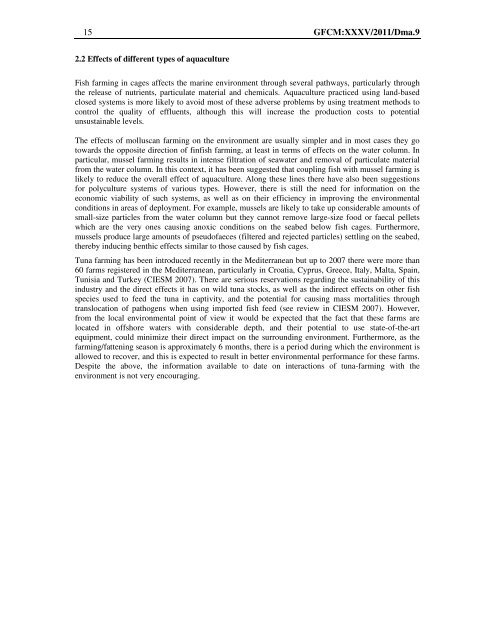Site selection and carrying capacity in Mediterranean ... - FAO Sipam
Site selection and carrying capacity in Mediterranean ... - FAO Sipam
Site selection and carrying capacity in Mediterranean ... - FAO Sipam
You also want an ePaper? Increase the reach of your titles
YUMPU automatically turns print PDFs into web optimized ePapers that Google loves.
15 GFCM:XXXV/2011/Dma.9<br />
2.2 Effects of different types of aquaculture<br />
Fish farm<strong>in</strong>g <strong>in</strong> cages affects the mar<strong>in</strong>e environment through several pathways, particularly through<br />
the release of nutrients, particulate material <strong>and</strong> chemicals. Aquaculture practiced us<strong>in</strong>g l<strong>and</strong>-based<br />
closed systems is more likely to avoid most of these adverse problems by us<strong>in</strong>g treatment methods to<br />
control the quality of effluents, although this will <strong>in</strong>crease the production costs to potential<br />
unsusta<strong>in</strong>able levels.<br />
The effects of molluscan farm<strong>in</strong>g on the environment are usually simpler <strong>and</strong> <strong>in</strong> most cases they go<br />
towards the opposite direction of f<strong>in</strong>fish farm<strong>in</strong>g, at least <strong>in</strong> terms of effects on the water column. In<br />
particular, mussel farm<strong>in</strong>g results <strong>in</strong> <strong>in</strong>tense filtration of seawater <strong>and</strong> removal of particulate material<br />
from the water column. In this context, it has been suggested that coupl<strong>in</strong>g fish with mussel farm<strong>in</strong>g is<br />
likely to reduce the overall effect of aquaculture. Along these l<strong>in</strong>es there have also been suggestions<br />
for polyculture systems of various types. However, there is still the need for <strong>in</strong>formation on the<br />
economic viability of such systems, as well as on their efficiency <strong>in</strong> improv<strong>in</strong>g the environmental<br />
conditions <strong>in</strong> areas of deployment. For example, mussels are likely to take up considerable amounts of<br />
small-size particles from the water column but they cannot remove large-size food or faecal pellets<br />
which are the very ones caus<strong>in</strong>g anoxic conditions on the seabed below fish cages. Furthermore,<br />
mussels produce large amounts of pseudofaeces (filtered <strong>and</strong> rejected particles) settl<strong>in</strong>g on the seabed,<br />
thereby <strong>in</strong>duc<strong>in</strong>g benthic effects similar to those caused by fish cages.<br />
Tuna farm<strong>in</strong>g has been <strong>in</strong>troduced recently <strong>in</strong> the <strong>Mediterranean</strong> but up to 2007 there were more than<br />
60 farms registered <strong>in</strong> the <strong>Mediterranean</strong>, particularly <strong>in</strong> Croatia, Cyprus, Greece, Italy, Malta, Spa<strong>in</strong>,<br />
Tunisia <strong>and</strong> Turkey (CIESM 2007). There are serious reservations regard<strong>in</strong>g the susta<strong>in</strong>ability of this<br />
<strong>in</strong>dustry <strong>and</strong> the direct effects it has on wild tuna stocks, as well as the <strong>in</strong>direct effects on other fish<br />
species used to feed the tuna <strong>in</strong> captivity, <strong>and</strong> the potential for caus<strong>in</strong>g mass mortalities through<br />
translocation of pathogens when us<strong>in</strong>g imported fish feed (see review <strong>in</strong> CIESM 2007). However,<br />
from the local environmental po<strong>in</strong>t of view it would be expected that the fact that these farms are<br />
located <strong>in</strong> offshore waters with considerable depth, <strong>and</strong> their potential to use state-of-the-art<br />
equipment, could m<strong>in</strong>imize their direct impact on the surround<strong>in</strong>g environment. Furthermore, as the<br />
farm<strong>in</strong>g/fatten<strong>in</strong>g season is approximately 6 months, there is a period dur<strong>in</strong>g which the environment is<br />
allowed to recover, <strong>and</strong> this is expected to result <strong>in</strong> better environmental performance for these farms.<br />
Despite the above, the <strong>in</strong>formation available to date on <strong>in</strong>teractions of tuna-farm<strong>in</strong>g with the<br />
environment is not very encourag<strong>in</strong>g.
















